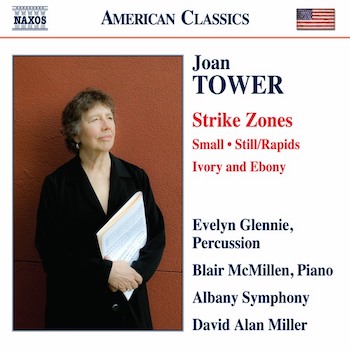Classical Album Review: Composer Joan Tower’s “Strike Zones”
By Jonathan Blumhofer
For Joan Tower fans, this disc is a must; for the Tower-curious, it offers an excellent introduction to the composer’s wider work, all of it compellingly played.
 Few conductor-and-orchestra pairings have done more to champion the concert music of contemporary American composers than David Alan Miller and the Albany Symphony Orchestra (ASO). Now entering their 30th season together, Miller and Friends show no signs of fatigue in their incisive new survey of concertos and chamber music by Joan Tower.
Few conductor-and-orchestra pairings have done more to champion the concert music of contemporary American composers than David Alan Miller and the Albany Symphony Orchestra (ASO). Now entering their 30th season together, Miller and Friends show no signs of fatigue in their incisive new survey of concertos and chamber music by Joan Tower.
Both of the concerti — Strike Zones (for percussion and orchestra) and Still/Rapids (for piano and orchestra) — are, in typical Tower fashion, admirably focused and spontaneously directed.
The former, which was premiered in 2001, offers a breathtaking play of colors throughout its 20-minute duration. Of course, it helps that Tower’s percussion sensibilities are always fresh and assured; Strike Zones certainly plays to her strengths. Even so, she revels with conspicuous success in the subtleties that arise from doubling and echoing the soloist within the orchestra.
Tower’s feel for structure in Strike Zones is exceedingly well-judged and her writing is motivically tight. There are timely shifts of timbre as well as moments of welcome surprise (like the score’s groovy intimations of jazz and improvised cadenzas).
Also, her tonal palate is decidedly on-point: Strike Zone’s blend of solo mallets, drums, cymbals, gongs, and so forth simply works — idiomatically, expressively, technically.
Then again, how couldn’t it, what with Evelyn Glennie taking the solo spotlight? The Scottish percussionist navigates Tower’s writing here with surety and aplomb. So do Miller and the ASO, even if some of the music’s spatial dialogues don’t quite come out in the mix.
Still/Rapids pairs two separate pieces for piano and orchestra that Tower wrote in 1995 and 2013. The first (and most recent), “Still,” is lush, sultry, and kind of jazzy to start, with sweet little lyrical flights emerging as it proceeds. “Rapids,” on the other hand, is stormy and motoric, full of brawny, athletic writing for both soloist and orchestra.
As played here by pianist Blair McMillan and the ASO, it proves a nifty little piano concerto, well sculpted and full of surprises (like the orchestral solos that emerge just before the first piano cadenza in “Rapids”). Both pianist and orchestra navigate the rhythmic minefields of Tower’s writing with confidence, color, and panache.
McMillan does more of the same in his traversal of Ivory and Ebony, Tower’s 2009 study in sonority written for that year’s San Antonio International Piano Competition. The music’s big range of tempos, textures, characters, and gestures may or may not add up to the sum of its parts. Either way, it’s gripping to hear McMillan’s rhythmically taut, resplendently colored account of these pages.
Similarly invigorating is Glennie’s performance of Small, a short 2018 essay for percussion instruments that can be “packed away in one little carrying case and be able to fit onto a tiny table.”
For Tower fans, this Naxos disc is a must; for the Tower-curious, it offers an excellent introduction to her wider work, all of it compellingly played.
Jonathan Blumhofer is a composer and violist who has been active in the greater Boston area since 2004. His music has received numerous awards and been performed by various ensembles, including the American Composers Orchestra, Kiev Philharmonic, Camerata Chicago, Xanthos Ensemble, and Juventas New Music Group. Since receiving his doctorate from Boston University in 2010, Jon has taught at Clark University, Worcester Polytechnic Institute, and online for the University of Phoenix, in addition to writing music criticism for the Worcester Telegram & Gazette.
Tagged: Albany Symphony Orchestra, David Alan Miller, Joan Tower, Jonathan Blumhofer
